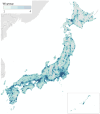Community-Level Compact City Design, Health Care Provision, and Outcomes of Patients With Stroke
- PMID: 40698591
- PMCID: PMC12449981
- DOI: 10.1161/JAHA.125.041293
Community-Level Compact City Design, Health Care Provision, and Outcomes of Patients With Stroke
Abstract
Background: The optimal scale of urbanization for stroke health care provision and the potential impact of compact city design on stroke outcomes remain unclear. We investigated the impact of zip code area-level compact city design using the walkability index (WI) and its mediators on stroke outcomes.
Methods: This nationwide retrospective study used data from patients with stroke from the J-ASPECT study (2017-2022). WI was calculated as the average of 3 Z-scored city design elements (population density, road connectivity, and variation in walkable facilities) from 113 1156 zip code areas in Japan. The association between WI and in-hospital mortality, functional independence at discharge, and medical costs was assessed using multivariable mixed-effects logistic regression model.
Results: Overall, 555 296 patients (median age, 75 [interquartile range, 66-83] years; female, 42.5%) from 818 hospitals were included. Higher WI was significantly associated with decreased in-hospital mortality (odds ratio [OR], 0.94 [95% CI, 0.92-0.96]) and increased functional independence (OR, 1.03 [95% CI, 1.02-1.04]). The highest WI group was associated with decreased mortality, primarily mediated by management in intensive or stroke care units (proportion mediated, 0.46 [95% CI, 0.35-0.63]), and the highest WI group was associated with increased functional independence, mediated by short road distance to the hospital (proportion mediated, 0.30 [95% CI, 0.21-0.44]).
Conclusions: Zip code area-level compact city design was associated with decreased in-hospital mortality and increased functional independence. Compact city design at community level, even without large-scale urbanization, may contribute to improving stroke care provision and outcomes in increasingly urbanized societies.
Keywords: city design; city environment; compact city; primary stroke center; stroke; urban; walkability.
Conflict of interest statement
None.
Figures





References
-
- United Nations DoEaSA, Population Division . World Urbanization Prospects 2018: Highlights. 2019.
-
- Ramos‐Pachón A, Rodríguez‐Luna D, Martí‐Fàbregas J, Millán M, Bustamante A, Martínez‐Sánchez M, Serena J, Terceño M, Vera‐Cáceres C, Camps‐Renom P, et al. Effect of bypassing the closest stroke Center in Patients with intracerebral hemorrhage: a secondary analysis of the RACECAT randomized clinical trial. JAMA Neurol. 2023;80:1028–1036. doi: 10.1001/jamaneurol.2023.2754 - DOI - PMC - PubMed
-
- Garcia‐Tornel A, Millan M, Rubiera M, Bustamante A, Requena M, Dorado L, Olivé‐Gadea M, Jiménez X, Soto A, Querol M, et al. Workflows and outcomes in patients with suspected large vessel occlusion stroke triaged in urban and nonurban areas. Stroke. 2022;53:3728–3740. doi: 10.1161/strokeaha.122.040768 - DOI - PubMed
-
- Pérez de la Ossa N, Abilleira S, Jovin TG, García‐Tornel Á, Jimenez X, Urra X, Cardona P, Cocho D, Purroy F, Serena J, et al. Effect of direct transportation to Thrombectomy‐capable center vs local stroke center on neurological outcomes in patients with suspected large‐vessel occlusion stroke in nonurban areas: the RACECAT randomized clinical trial. JAMA. 2022;327:1782–1794. doi: 10.1001/jama.2022.4404 - DOI - PMC - PubMed
MeSH terms
LinkOut - more resources
Full Text Sources
Medical

